- Country Areas
- Methods and indices
- Explore oral health
- About CAPP
-
- Bank of Ideas
- Nepal - Basic Oral Health Training Programme for the Health Workers of Ramechhap District
- Nepal - Manang Dental Camp Report
- Nepal - School based oral health project in remote Timal Besi
- Nepal - Training Female Community Health Volunteers in Oral Health Education
- United Kingdom - Fissure Sealant Programme for Schoolchildren in Wales
- United Kingdom - Boost Better Breaks - A School based Public Health Programme in Northern Ireland
- United Kingdom - Training programme for nursing staff on oral health care of elderly residents of nursing homes in Scotland
- United Kingdom - An Oral Cancer Awareness Campaign Programme, Scotland
- United Kingdom - Designed to Smile - Promoting Better Oral Health and Delivering Fluoride Supplementation to Children in Wales
- United Kingdom - Childsmile – the national child oral health improvement programme for Scotland
- Sweden - A school-based fluoride mouth rinsing programme
- Kenya - The Eric Dental Clinic
- Madagascar - The Vezo Hospital
- Nigeria - A School based oral health education programme for Children
- Seychelles - Dental Public Health Programmes
- South Africa - Hammanskraal Project
- South Africa - Phelophepa Healthcare Train
- Afghanistan - Dental Relief Project, Kabul
- Australia - Water fluoridation in remote Aboriginal communities
- Australia - An Aboriginal health and a Government school dental service in South Australia
- Austria - Oral Health Promotion Programme for preschool children, Vorarlberg
- Antigua and Barbuda - School based Fluoride rinse programme, 1989-1998
- Brunei Darussalam - Mission Report 1998 on training course in oral health survey method
- Cambodia - Mobile dental care for schoolchildren in Sihanoukville
- Cambodia - Outreach programme for improving oral health of under privileged children in Sihanoukville
- Cambodia - Oral Health promotion in schools in Kampong Cham
- Namibia - The "Smiling Schools" project
- South Africa - An Atraumatic Restorative Treatment (ART) Project: Activity Report
- South Africa - An Atraumatic Restorative Treatment (ART) in a Mobile Dental Clinic, Johannesburg
- Tanzania, United Republic of - The Outreach programme in primary schools around the Dar es Salaam area
- Argentina - An Oral Health Preventive Programme for School Children
- Brazil - Atraumatic Restorative Treatment for a disadvantaged Brazilian Community
- Chile - A school based oral health programme in Cabildo (2008)
- Chile - Fluoridated milk programme for rural primary school children
- Chile - Fluoridated Powdered Milk Programme
- El Salvador - Community-based programme for prevention of dental caries among children
- Honduras - Oral Health Education and Care for a resource poor Honduran community
- Honduras - Oral Health and Care in Delicias
- United States of America - Oral Health Programme for Navajo Indians in Pine Hill, New Mexico
- United States of America - Oral health Education and Sealant programme for West Philadelphian Schoolchildren
- Kuwait - A school based oral health programme during 1986-1997
- Kuwait - Community Based Schoolchildren's Oral Health Programmes 1985 -1998
- Kuwait - School Oral Health Programme (1982-2011)
- Lebanon - Final Report, a baseline survey of oral health situation and fluoride levels in drinking water (2000)
- Saudi Arabia - An ongoing oral health promotion programme
- Saudi Arabia - The Celebration of the 20th anniversary of the accession to the throne of King Fahd Ibn Abdul-Aziz
- Saudi Arabia - Oral Health Education Programme for schoolchildren in the Holy City of Mecca
- Sudan - An Oral Health Promotion through live art in Sudan
- Syrian Arab Republic - An ongoing oral health preventive programme
- United Arab Emirates - Assignment Report 1995-96 with recommendations to build a comprehensive oral health care
- United Arab Emirates - Dental Public Health Programs implemented by Dental Services Department, Dubai
- United Arab Emirates - MY SMILE” - tooth brushing program for school children in Dubai, UAE.
- Bulgaria - A community based milk fluoridation programme 1988-1993
- Bulgaria - The clinical effect of milk fluoridation for school children
- Croatia - Healthy Smile Day
- France - A School Based Oral Health Education Programme
- Germany - Third German Oral Health Study - 1997, Summary
- Germany - An Oral health programme for children attending kindergartens in two Counties in Northern Hesse
- Romania - Fluoride mouth rinsing Programme in Schools in Constanta and Iasi connties (2001-2010)
- Russian Federation - Programme focusing educating parents of infants on the prevention of caries, Moscow
- Sweden - An oral health programme for preschool children in a multicultural city area
- Sweden - The Oral Health Lift - An Oral Health Promotion Programme for the Homeless and other socially vulnerable people in Malmö
- Sweden - School based fluoride varnish application programme
- Turkey - Ongoing Atraumatic Restorative Treatment (ART) Programme in some rural areas
- Turkey - A reliable and practical dental preventive/education program model for Turkey - "brushes in the bags, teeth on the healthy-way"
- India - Training oral health workers to provide basic dental care in Ladakh
- Indonesia - Affordable toothpaste project (WHO) in West Kalimantan
- Sri Lanka - School based public health programme in Jaffna
- Sri Lanka - ART Training Programme for School Dental Therapists, Jaffna
- Sri Lanka - An oral cancer screening project in tea estates
- Sri Lanka - Oral Health Camp in rural area
- Sri Lanka - Dental public Health Programmes conducted by the Population Oral Health Unit (Community Dental Unit), Dental Institute, Colombo
- Thailand - The Royal Mobile Dental Unit project
- Thailand - School based oral health programme for children in Southern Thailand
- China - A campaign on "Love Teeth Day" celebrated nation-wide each year
- China - Milk fluoridation project (WHO) in Beijing
- China - An oral health education programme in Wuhan City
- China - An oral health education and supervised tooth brushing programme in kindergartens
- Japan - A school-based fluoride mouth rinse programme for preschool children
- Japan - Visual Support Material for Children with Autism in order to Master Toothbrushing Skills
- Viet Nam - School-based Oral Health Programme
- Viet Nam - Mission report 1999 with recommendation for oral health training
- Viet Nam - Oral health program in South Central Vietnam
- Vanatu - Mission Report on Oral Health
- Tonga - Mission Report 1997 reviewing the oral health programme
- Tokelau - Mission Report 1999 on recommendation to improve oral health
- Philippines - Mission Report 1998 on planning and implementing a national oral health survey
- Philippines - The Essential Health Care Package- “Fit for School” programme
- Mongolia - Mission Report 1999 with recommendations to improve oral health (1)
- Malaysia - reports from Oral Health Division
- Lao PDR - Caries prevalence and some caries related factors for 12-year-old children from Vientiane and Luang Prabang provinces
- Lao PDR - Estimating the fluoride concentration in the drinking waters
- Korea, Republic of - Community based caries prevention programme in a suburban area
- Sri Lanka - An ongoing school-based ART Programme
- Vanuatu - Gudfala Tut Skul Program (Healthy Tooth School Program)
- Estonia - Suukool, a mouth school
- Palestine - Integrating the WHO Health Promoting School Concept into National School Oral Health
Indonesia - Affordable toothpaste project (WHO) in West Kalimantan
Indonesia - Affordable toothpaste project (WHO) in West Kalimantan
School-Based Primary Preventive Programme for Children. Affordable toothpaste as a component in primary oral health care - Experiences from a field trial in Kalimantan Barat, Indonesia
Introduction
During the past two-three decades, there has been a substantial reduction in dental caries in many developed countries. For example, in some countries caries prevalence declined from a mean DMFT (mean number of sum of Decayed, Missing and Filled Teeth) of 6 - 8 to less than 1.5 for 12-year-olds. Caries free children, who were a rarity in the middle of this century, are now often seen in these countries and may constitute more than 50 per cent of the age group. These positive changes have been clearly reflected in reports to the Global Oral Data Bank (GODB) of the Oral Health programme, World Health Organization (WHO), which began in 1969. Recent data indicate that caries is still declining in many countries, but at a reduced rate. Detailed information for several WHO member-states is now available at the GODB presentation on the Internet, the Oral Health Country/Area Profile Programme (CAPP).
In developing countries, the situation is more varied. The prevalence of dental caries has remained low in populations who have continued their traditional dietary patterns and habits. However, with changing living conditions and life-style due to industrialisation, an increase in dental caries has been reported in several developing countries. This situation is certainly very worrying, since the increase in disease in countries with limited dental manpower results in pain, infection and large amounts of untreated disease.
The important question therefore is - how to control this situation? What acceptable and affordable actions can and should be taken to reduce the prevalence and extent of dental caries in developing countries with increasing disease levels? This publication will address this crucial issue and present one method - the "affordable fluoride toothpaste" approach, including results from a large field trial.
Rationale
The Oral Health programme (ORH) has during the years published a number of reports within the WHO Technical Report Series (13, 14, 17, 18, 19, 38, 39, 42, 43, 48, 50), which have explored various methods and programmes to promote oral health. Although research and community trials have demonstrated the potential benefits of several preventive methods, not all are appropriate in developing countries. For example, the implementation of water fluoridation require an adequate infrastructure and proper technology, which may not be available in many areas in the developing countries.
Two publications are of particular interest in this context, as they present highly relevant reviews: Recent advances in oral health (44) and Fluorides and oral health (20). A number of recommendations to promote oral health have been presented in the two publications referred to. In particular, self care and a healthy life-style were emphasised. These would include the use of a fluoride toothpaste and a limited number of caries-inducing snacks per day. However, it should be realised that controlling dietary patterns and stopping the anticipated increase in sugar consumption is not easily achieved. Therefore it is of special interest to investigate how industrialised countries have succeeded in reducing the caries prevalence, despite the substantial consumption of sugar.
In a recent publication, titled 'Reasons for the caries decline: what do the experts believe?' (11), this issue was looked at in more detail . The aim of the study was to determine what experts today, based on their total scientific experience, 'believe' are the main reasons for the caries decline seen in westernised countries over the past 3 decades. The question they had to answer was "What are the main reasons why 20-25-year-old persons have less caries nowadays, compared to 30 years ago?". There was considerable variation in the responses of the experts but there was a clear agreement that the use of fluoride toothpaste, and water fluoridation has had a definite positive effect.
Many studies (25) have demonstrated significant caries reductions as a result of fluoride toothpastes. The findings clearly indicate that the introduction of toothbrushing programmes using a fluoride toothpaste would have a significant impact in developing countries. Such measures are, in addition, also beneficial from a periodontal point of view, as was recently pointed out in a WHO publication, dealing with oral health programmes in ex-USSR countries (30). There is, however, an important factor to consider when trying to transfer this concept to developing countries. In a comprehensive review of disease control priorities in developing countries (10), the problem was defined as:
"It is believed that fluoride toothpaste and other fluoride containing products have been of great importance in decreasing the prevalence of caries in industrial countries. The use of such products in developing countries should be promoted, but the outcome of such activities is also dependent on the price of the products. New products, more affordable than those produced today, must become available."
Such considerations provided the background for the present project, which aimed to encourage commercial companies to produce an 'affordable fluoride containing toothpaste' and to assess this product in a developing country with high caries levels.
Objectives
The objectives of the project were to:
- encourage companies to produce an 'affordable fluoride containing toothpaste'
- include such a product in a preventive school health programme in a developing country and evaluate the total programme for its efficacy
- make general recommendations based on the results of the study
These objectives are considered in more detail below.
Establishing the basis for the project
The general outline of the project was discussed at the WHO Geneva in 1989 and 1990 and was followed by letters to some of the major international toothpaste companies, urging them to consider producing an 'affordable fluoride toothpaste'. Discussions with company representatives followed on several occasions, and the first company to present a product ready for field testing was Colgate-Palmolive, Piscataway, USA.
The next step was to identify a country willing to host the project and one which could serve as an example to those countries having areas undergoing rapid development with a concomitant increase of dental caries. Several such countries were identified and finally it was decided to approach Indonesia. Contacts were established with the Directorate of Dental Services, Ministry of Health, Jakarta in 1991. After a thorough review of the issue, plans were drawn up for a situation analysis in the proposed province of West Kalimantan. Prior to this, a number of contacts were made with WHO Regional and Country representatives and with central Indonesian administrative bodies. A visit to the selected area took place in 1992 and included discussions with authorities at provincial as well as at district levels, to assure acceptance of the project. Based on these preparations, a research protocol was drafted and circulated among the parties involved. It was thus decided to perform a school-based oral health project where the 'test' group (intervention group) had one daily supervised toothbrushing activity with the new toothpaste, and the 'control group' was not interfered with, with the exception of the dental recordings (it was deemed unethical to use a non-fluoridated toothpaste). Consensus was reached for the following specific objectives to:
- record the DMFT of both test and control groups at baseline examinations and at repeated examinations after two and three years
- study the mutans streptococci levels in saliva of both the test and control groups, and to verify if these levels changed during the course of the project
- collect information on the oral hygiene of both the test and control groups, and to study if the oral hygiene was changed during the course of the project
- obtain information on knowledge, attitude and practice in oral health among both the test and control groups at baseline and after three years (this part of the project will not be reported in the present publication)
- use and evaluate an appropriate strategy for oral health supervision regarding the use of "affordable toothpaste" among school children and to implement the intervention using this strategy during the period of research
- draw up a recommendation to the government for using the research strategy as a basis for developing policies on the reduction of dental and oral diseases among school children.
After agreements on management responsibilities, the baseline examinations were performed in 1993.
Materials and methods
Venue
Among the different provinces of Indonesia, the provinces of Kalimantan (the Indonesian section of the island of Borneo) have attracted special attention due to the relatively high caries prevalence (urban areas DMFT 7.15 for 14-year-olds) according to records at the Departemen Kesehatan Republik Indonesia, Direktorat Jenderal Pelayanan Medik, Direktorat Kesehatan Gigi (29). Kalimantan is scarcely populated by Indonesian standards. The province of West Kalimantan (Kalimantan Barat), which was selected for the project, has a population density of 22 ind. /km2 compared to 833 ind. /km2 in Java. The principal type of community is rural, the exception being the province capital Pontianak with a population of approx. 300 000.
Three districts (Kabupaten) were selected for the study (see Fig. 1), North (Sambas), South (Ketapang) and East (Sanggau) of Pontianak respectively. Sambas holds a relatively high concentration of ethnic Chinese and in Sanggau, there is an influence of the Dayak population. In each of these districts, four primary schools from urban areas and four schools from rural areas were selected. Two urban schools and two rural schools in each district were allocated to receive intervention and two urban schools and two rural schools served as control; a total of 12 test and 12 control schools. Thus, matching for allocation to test or control was done at school level and the matching was based on the community type (urban/rural).
Fig. 1. The location of the districts Sambas (1), Sanggau (2) and Ketapang (3), selected for the evaluation of the preventive programme in the Indonesian province Kalimantan Barat on the island of Borneo.
Study population
The distribution of children per district at baseline is presented in Fig. 2. The total number of children (intervention+controls) at baseline was 2141. The sample suffered a drop out of 25% over the three years of the study, the drop out being more pronounced in the district of Sambas. There were no significant differences in the drop-out rate between test and control, male and female or urban and rural children. No assessment was done to the reasons for drop out but it appeared that migration was an important reason.




Figure 2
The sample constituted all children of selected schools who attended grade one, two and three at baseline. In these grades, the age of the children was not homogeneous (Fig. 3) and as a result, there was a wide age span in the sample. However, it was decided to include all children in the selected grades and not exclude a few, being either too young or old compared to the mean of the group.
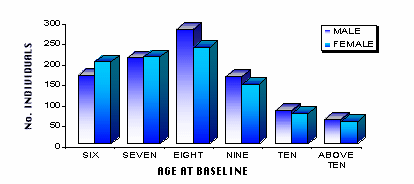
Figure 3
As a result of the wide range of ages, there were also differences in the development of the dentitions, expressed as number of permanent teeth (Fig. 4). However, at the conclusion of the study the distribution of the number of permanent teeth was not significantly different in test and control group (Fig. 5).

Figure 4
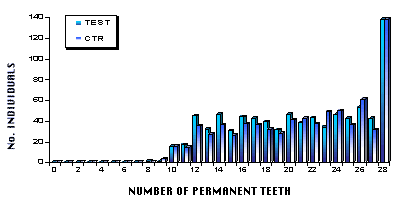
Figure 5
Oral Health Programme
The oral health programme was developed and managed by the local health and school authorities after the initiation by staff from the Ministry of Health. At each study site, the focal person in charge of the programme was usually one of the dentists in the district and this person had the responsibility to distribute material to the schools and support their activities. The staff of the schools organised and supervised toothbrushing in order to adapt it to the work at their particular school. Toothbrushes and toothpastes were stored at the schools, for example in specially designed cupboards of local manufacture. A number of instructions, not to be deviated from, were given: to carry out the toothbrushing once a day, to apply toothpaste on the full length of the brush, to brush for at least one minute and to rinse with water only once after brushing.
Toothpaste and toothbrushes, were kindly donated by Colgate-Palmolive Inc. The toothpaste, produced according to the specifications for the "Affordable toothpaste" and containing 1000 ppm fluoride as monofluorophosphate, was delivered in plain white tubes with text indicating their origin and intended use in the study. Toothbrushes were provided in a quantity of 4 per year and were of soft quality. The material was distributed to the districts by the provincial health service.
Composition of toothpaste
In 1990, the World Health Organization requested major toothpaste manufacturers to develop an affordable cost of toothpaste (ACT) with fluoride that WHO could test clinically for anti-caries efficacy in children. In response to this request Colgate developed a new formula which consists of a combination of humectants, water, precipitated calcium carbonate (PCC), and sodium monofluorophosphate (MFP) as the anti-caries fluoride source. Additionally, the dentifrice was formulated with surfactant and flavour to improve the mouthfeel, and a special combination of preservatives to eliminate bacterial growth in the toothpaste.
A number of factors led to PCC being selected as an abrasive for the ACT project. First of all, it is readily available in developing countries, and is effective in removing plaque and debris from teeth. In addition, PCC is likely to add to the buffering effect of saliva during a pH drop in dental plaque. Finally, there is considerable experience of the use of similar toothpastes. Numerous clinical trials have been published, showing anti-caries effects of PCC/MFP combinations. (16, 21, 22, 23, 31, 32, 33, 34, 36, 40, 41, 49, 51, 52).
The formula was optimized by using raw materials with appropriate specifications with regard to particle size, purity, soluble calcium, alkalinity, heavy metal content, whiteness, and bacteriological counts. All of these specifications ensured that the product contained a PCC/MFP system with optimal stability which gives long lasting availability of fluoride. Also, it would not support bacterial growth, and it was safe to use.
The particle size distribution of the PCC used in this toothpaste was also designed to provide sufficient cleaning, while not being too large as to cause excessive wear for dental tissues, or too small which increases surface area of contact that may create problems with fluoride stability.
Calcium carbonate is the major constituent of this product, and is usually not optimally compatible with fluoride sources over a long period of time. Since fluoride is the anti-caries agent in the formula, the compatibility of this ingredient with abrasives such as PCC is extremely important. For example, in alkaline solutions, the monofluorophosphates ions dissociate according to the following reaction:
PO3F2 + OH ® F + HPO4 2
By this reaction, fluoride ions are liberated in the aqueous phase of the toothpaste. Fluoride ions will then react over time with PCC in the following equilibrium reaction:
2F+ CaCO3 (s)Û CaF2 + HPO3 2-
In order to prevent this reaction, a stabilizer was used, which reduces the occurrence of this reaction and shifts the equilibrium away from CaF2 formation. In that case, the amount of fluoride loss due to its interaction with this abrasive system is reduced and the formula will have enhanced anti-cavity protection for a longer period of time. (53, 54, 55, 56, 57, 58).
Several stabilizers are available to reduce fluoride loss in toothpastes of this kind, but some interfere with fluoride efficacy in vitro. In this case a stabilizer which significantly reduces fluoride inactivation by the PCC abrasive without interfering with its in vitro anti-cavity efficacy was used.
In summary, there was a toothpaste, which is potentially highly effective in reducing caries incidence. This product contains an abrasive composed of precipitated calcium carbonate, and a compatible fluoride system which prevents plaque pH from decreasing significantly. The level of fluoride in the toothpaste is 1000 ppm and the dentifrice also contains surfactant and flavour to improve mouthfeel, and a special combination of preservatives to prevent bacterial growth.
Additionally, critical raw materials such as PCC satisfy relevant raw material specifications in order to produce a high quality but affordable cost of toothpaste. PCC is then the abrasive of choice for the affordable toothpaste formula because of its low cost without compromising efficacy when compared to the more expensive silica dentifrices. Although PCC is preferred, some natural chalks may also possess the key desirable properties to make high quality, low cost dentifricies.
Data collection
Dental caries
In order to make the present data available to comparisons with other studies, the DMF teeth index according to WHO was selected for expressing data for dental caries. The diagnostic criteria were as outlined by WHO (37) and the methodology followed the WHO recommendations; diagnosis was made with the aid of a dental explorer and a mouth mirror in indirect natural light.
Dental caries prevalence (DMFT) was calculated as the individual sum of D, M and F teeth. The dental caries incidence was calculated as the individual difference in DMFT between baseline prevalence and the examination after two and three years. "Reversals" (teeth with the diagnosis of caries at baseline with a subsequent diagnosis of being sound at the follow up examinations) were calculated as having negative incidence.
Toothcleaning efficiency
The criteria of the widely adopted Simplified Debris Index (24) were selected for the evaluation of the toothcleaning. The surfaces examined were the buccal surfaces of 16 and 26, the labial surfaces of 11 and 31, and the lingual surfaces of 36 and 46. The presence of debris was recorded with the aid of a dental explorer, moved perpendicular to the tooth surface.
A score was assigned to each present index tooth according to the index.
Score 0: No Debris
Score 1: Debris covering no more than the cervical 1/3 of the crown.
Score 2: Debris covering no more than the cervical 2/3 of the crown.
Score 3: Debris covering more than 2/3 of the crown.
Calibration
The recording of the clinical findings were carried out by six examiners, two for each district and with the same two examiners being allocated the same district throughout the study. In one district, Sambas, one examiner was replaced after two or three years due to deteriorating health. Before the annual examinations, the six dentists were calibrated in the caries diagnosis using a cross- examination/re-examination protocol. The calibration was performed on school children in the same age group and the same caries prevalence as the sample, but did not involve children in the actual sample.
Salivary mutans streptococci
Mutans streptococci are widely recognised as the initiators of the caries lesion (9) and have a number of features directly related to their cariogenicity. Their prevalence in saliva is in many populations associated with an increased caries prevalence (8).
The salivary level of mutans streptococci was determined at baseline and after two years in the sample in the district of Sanggau. The Strip. mutans method (27) was adopted and the sample collected prior to the clinical examination. The samples were incubated at site in portable incubators and dried for later scoring by an independent observer. Scoring was done according to the model chart provided by the manufacturer. The scores correspond approximately to the following salivary counts of mutans streptococci:
Score - Mutans streptococci colony forming units/ml saliva
Zero: < 10 000
One: 10 000 - 100 000
Two: 100 000 - 1000 000
Three: > 1 000 000
Statistics
All statistical tests were performed using the Statistica software (StatSoft Inc., Tulsa, OK, USA.). The level of significance for all tests was set at p< 0.05. Where applicable, the actual values obtained are presented in the results sections.
RESULTS
Dental caries
The efficacy of the preventive programme was clearly demonstrated in the caries increment figures from the two groups (Table 1).
Table 1. DMFT increment in testgroup compared to control-group for different
age groups expressed as "% lower DMFT increment".
| Age at baseline | % lower DMFT increment in testgroup compared to control-group |
| 6 | 22 |
| 7 | 21 |
| 8 | 40 |
| 9 | 16 |
| >9 | 12 |
| All age groups | 23 |
If analysed in terms of total dental caries increment during the three years (Fig. 6), it can be concluded that significantly fewer new teeth were attacked by caries in the test group (ANOVA, F=7.97, p=.005) compared to the control group. In addition, there was a considerable interaction between age and study group (F=2.68, p=0.015) with the younger age groups responding more to the supervised brushing with the fluoridated toothpaste.
The caries incidence was made up almost exclusively of the D component.

Figure 6
The age groups exhibiting a reduced mean caries increment were further analysed in terms of outcome for the subjects.
First, the difference in frequency of cariesfree subjects was compared in test and control group. This comparison was made among subjects free from caries at the baseline examination (Fig 7) and revealed that up to 10 percent more children were cariesfree in the test group. For those children already affected by caries in the permanent dentition at baseline, the same comparison was applied but a successful outcome was defined as having no new caries lesions in the permanent dentition (Fig 8). Also in this case, the proportion with no caries increment was higher in the test group by up to 19 percent.

Figure 7

Figure 8
Toothcleaning efficiency
The change in median Debris Index (DI) between the baseline and the final examination differed significantly between the test and the control group (Mann-Whitney U-test, U=196763.0, p=0.000). The distribution of subjects according to treatment and change in median DI score is presented in Fig. 9. A positive change indicates a reduction in median DI (less debris) and a negative change indicates an increase in median DI score (more debris).

Figure 9
Mutans streptococci
The mutans streptococci were demonstrated in most of the samples (Fig. 10) both at baseline and after two years. A considerable proportion of the children were harbouring mutans streptococci in high or very high numbers (score 2 and 3). The individual levels of bacteria varied over time, the contingency coefficient being 0.20 for the test group and 0.30 for the control group.
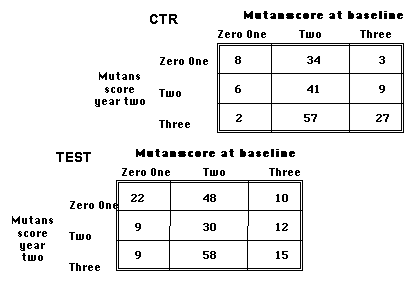
Figure 10
Dental caries in relation to DI score significantly
Dental caries prevalence at baseline was related to median DI (ANOVA, F=28.42, p= 0.000) and this was also true for the three year caries incidence and DI at the final examination (ANOVA, F=3.76, p=.001) as demonstrated in Fig. 11.
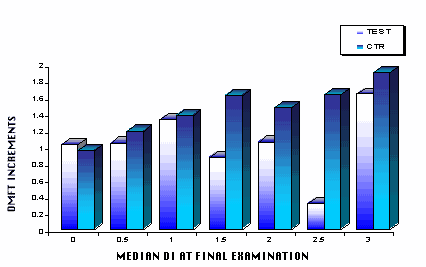
Figure 11
Dental caries in relation to mutans streptococci
In the subsample from Sanggau where the level of mutans streptococci was determined, the mean caries incidence increased with increasing levels of mutans streptococci (Fig. 12), although the differences, were not statistically significant (ANOVA, F=1.39, p=0.24).
The relationship between prevalence of mutans streptococci at baseline examination and caries incidence (DMFT increment) during the study.


Figure 12
Discussion
This clinical trial had a number of different but important components. It includes organisational and management matters at all levels from the Ministry of Health to the class-room, the development and selection of suitable oral health products, and an evaluation of these products in a developing country with high caries levels.
The use and benefits of a fluoridated toothpaste when used in a supervised school dental health programme, has been demonstrated previously in several studies. This study in contrast to most others was run in an area with scarce resources and different living conditions. The value of reduced caries incidence has to be considered in relation to the general 'survival' of a population in competition with many other urgent needs. The main outcome of this project was that it demonstrated that it is possible to establish a caries preventive programme in such conditions, and significant caries reductions were obtained.
There is a saying that "a chain is as strong as its weakest link". Transferring this proverb to our chain of events, there was one particular link which had significant impact on this project, namely the commitment of teachers and headmasters of the schools, supervising the children. Their enthusiastic involvement and repeated encouragement of this group of people is essential for the success of such a project. On the whole, this seemed to work well in the study despite some temporary problems due to change in local staff.
Another link requiring serious consideration is the transportation of products to remote areas. In this respect, the involvement of persons both at province and district levels are important. One of our project areas was accessible only by boat or air and then by truck. Two of the rural schools suffered a lack of toothpaste for about two months due to transportation problems. A further aspect worth consideration is that products should have minimum extra package covers, to minimise space and weight and waste disposal.
These factors serve to highlight the fact that any preventive method must be well adjusted to the community context. This programme was developed in close collaboration with the local network in the community which favoured a practical and less formal approach to solving potential problems. In fact, due to the enthusiasm of all participants in the area, some control schools started toothbrushing and oral health information activities, although they were less intensive compared to test schools. Due to ethical reasons, these activities were not stopped, but probably reduced the expected caries incidence in the control group.
Numerous studies have investigated the impact of supervised toothbrushing with fluoridated toothpaste on oral health in industrialised countries (7,26,28,47). In the early studies, the effect of different fluoride salts in the toothpaste was also addressed (15). However, the focus in this study was primarily the feasibility of introducing a supervised programme of toothbrushing with a fluoride tooth paste in a rural area in a developing country. The statistically significant reduction in mean DMFT increment obtained in this study, 23%, compares favourably with the average DFS/DMFS reduction of 24% reported by DePaola in a review (15). These reductions are thus of the same magnitude as those found in the West Kalimantan schools, indicating a beneficial effect of a supervised brushing programme without limitations to the setting.
The high caries prevalence in Kalimantan was associated with the presence of cariogenic microorganisms, the mutans streptococci, in the population. At baseline, the mutans streptococcal 'load' was relatively high, with 86 % of the Sanggau group having Strip. mutans scores of 2 or 3 (Fig. 10). The presence of these organisms may partly explain the rapid deterioration of the oral health in the region, following the introduction of refined foodstuffs. After two years, the Strip Mutans values had decreased to 69 % but there was no significant difference between test and control group. This reduction may have been due to exfoliation of carious primary teeth carrying mutans streptococci, as observed earlier in Thailand (46), and improved levels of oral hygiene in both groups. However, it has been shown that even after meticulous professional toothcleaning, it is difficult to obtain anything more than a temporary reduction in mutans streptococci levels (3).
The correlation between oral hygiene and caries has been a controversial issue (1,4,5). In the present study, there was a significant correlation between the DI score and the caries prevalence at baseline, and between the DI score at the final examination and the DMFT increment over the three years. It seems reasonable to consider a synergistic effect between the improved levels of oral hygiene and the fluoride exposure, as has been suggested earlier (45). If such a programme was expanded to further provinces and areas, and for prolonged time, it can be expected that the populations would obtain significant positive health benefits. It should be realised that the use of fluoridated toothpastes among young people in the capital of Jakarta already is very high (35). Repeated motivation and reinstruction based on individual needs should make it possible to further improve the programme (2).
What is an 'affordable toothpaste'? The proposition was that such a toothpaste should be available at a price which enables people on low income to purchase such a product. This is not possible to define in terms of rupee, yen, cent, öre, rubel, dollars or any other currency. The cost of the product should be seen in relation to the relative costs of other daily requirements. During the collection of background information for this project, the cost for toothpaste was compared with the price of sugar in some developing countries. In some instances, the cost of one tube of toothpaste sometimes was equal to several kilograms of sugar. Since sugar is an important source of calories it is easy to understand why those on low income give priority to this rather than a tube of expensive toothpaste.
The cost of the 'affordable toothpaste' used in this study cannot be defined precisely at this stage since it depends on a number of factors, which include the cost of raw materials and production. Nevertheless, the product used in this study has the potential to be significantly less expensive than others and this product has been shown to be effective in a community trial. It is hoped that its price compared with other products, for example sugar, should be significantly more favourable than at present. However, there still remains the question of how people will prioritize their spending. Therefore, an affordable product must be combined with continuous health education and motivation. Any further reduction of the cost would mean that more children could be covered by the programme.
Conclusions and recommendations
- A supervised school-based toothbrushing programme that was arranged in a developing country setting over a period of three years resulted in a reduction of caries incidence by 12-40% for different age groups compared to control groups.
- A toothpaste was developed which was affordable to as many people as possible.
- Any preventive project to be conducted in developing countries should carefully consider the community characteristics. Encouragement and involvement of local personnel is of crucial importance.
- Supervised school health programmes should be considered by authorities as one effective way of reducing dental caries and should be introduced if other ways have not proven more accurate results.
Acknowledgements
We acknowledge the support and participation of the children, school-teachers and headmasters, local administrators, dentists and other health personnel in Indonesia who helped us to perform the survey. Administrative assistance was obtained from the World Health Organization, the Ministry of Health Jakarta, Lund University, Sweden, and from the SPPP-project, Sweden. The project was supported by a grant from Colgate-Palmolive Inc., to whom we gratefully acknowledge their kind assistance in developing new technology and for providing the oral health products used in the study.
References
Andlaw RJ. Oral hygiene and dental caries--a review. Int Dent J 1978;28:1-6.
Axelsson P, Buischi YA, Barbosa MF, Karlsson R, Prado MC. The effect of a new oral hygiene training program on approximalcaries in 12-15-year-old Brazilian children: results after three years. Adv Dent Res 1994; 8:278-284.
Axelsson P, Kristoffersson K, Karlsson R, Bratthall D. A 30-month longitudinal study of the effects of some oral hygiene measures on Streptococcus mutans and approximal dental caries. J Dent Res 1987; 66:761-765.
Bellini HT, Arneberg P, von der Fehr FR. Oral hygiene and caries. A review. Acta Odontol Scand 1981; 39:257-265 .
Bjertness E. The importance of oral hygiene on variation in dental caries in adults. Acta Odontol Scand 1991;49:97-102.
Blake-Haskins J, Banoczy J, Gintner Z, Dombi C, Gaffar A and Volpe A. The effect of bicarbonate/fluoride dentifrices on human plaque pH. J Clin Dent 1997 (in press).
Bowen WH. The role of fluoride toothpastes in the prevention of dental caries. J R Soc Med 1995; 88:505-507.
Bratthall D. 1991. The global epidemiology of mutans streptococci. In: Risk markers for oral diseases, 288-312. Cambridge University Press. Ed: N W Johnson.
Bratthall D, Carlsson P. 1989. Clinical microbiology of saliva. In: Human Saliva: Clinical Chemistry and Microbiology. Chapter 7. CRC Press Inc, Boca Raton, Florida, USA. Ed: Tenovuo J O.
Bratthall D, Barmes D E. 1990. Oral Health. In: Disease control priorities in developing countries Washington DC: Population, Health and Nutrition Division, The World Bank, p.647-659. Ed: Jamison D T, Mosley W H.
Bratthall D, Hänsel-Petersson G, Sundberg H. Reasons for the caries decline: what do the experts believe? In: Dental Caries: Intervened - Interrupted - Interpreted, Suppl Eur J Oral Sci 1996; 104:416-422.
Colgate unpublished data.
Dental education. Report of a WHO Expert Committee on Dental Health. Geneva, World Health Organization, 1962 (WHO Technical Report Series, No. 244).
Dental health education. Report of a WHO Expert Committee. Geneva, World Health Organization, 1970 (WHO Technical Report Series, No.449).
De Paola P. Clinical studies of monofluorophosphate dentifrices. Caries Res 1983; 17(Suppl 1):119-135.
Downer MC, Holloway PJ and Davies TGH. Clinical testing of a topical fluoride caries preventive programme. Brit Dent J 141(8):242-7, 1976.
Epidemiology, etiology, and prevention of periodontal diseases. Report of a WHO Scientific Group. Geneva, World Health Organization, 1978 (WHO Technical Report Series, No. 621).
Expert Committee on Water Fluoridation. Geneva, World Health Organization, 1958 (WHO Technical Report Series, No. 146).
Expert Committee on Auxiliary Dental Personnel. Geneva, World Health Organization 1959 (WHO Technical Report Series, No. 163).
Fluorides and oral health. Report of a WHO Expert Committee. Geneva, World Health Organization, 1994 (WHO Technical Report Series, No. 846).
Gerdin P. Studies in dentifrices, VI. The inhibiting effect of some grinding and nongrinding fluoride dentifrices on dental caries. Swed Dent J 65:521-532, 1972.
Glass RL and Shiere FR. A clinical trial of a calcium carbonate base dentifrice containing 0.76% sodium monoflurophosphate. Caries Res 12:284-289, 1978.
Glass RL. Caries reduction by a dentifrice containing sodium monofluorophosphate in a calcium carbonate base; Partial explanation for diminishing caries prevalence. Clin Pre Dent 3(4):6-8, 1981.
Green JC, Vermillion JR. The simplified ortal hygiener index. J Amer Dent Ass 1964; 68:7.
Hänsel-Petersson G, Bratthall D. The caries decline: a review of reviews. In: Dental Caries: Intervened - Interrupted - Interpreted, Suppl Eur J Oral Sci 1996; 104:436-443.
Holt RD, Murray JJ. Developments in fluoride toothpastes- an overview. Community Dent Health 1997; 14:4-10.
Jensen B, Bratthall D. A new method for the estimation of mutans streptococci in human saliva. J Dent Res 1989; 3:468-471.
Konig KG. Role of fluoride toothpastes in a caries-preventive strategy. Caries Res 1993; 27 Suppl 1:23-28.
Laporan Hasil Survey Penyakit Periodontal dan Karies Gigi Tahun 1984-1988. Publ. by: Departemen Kesehatan Republik Indonesia, Direktorat Jenderal Pelayanan Medik, Direktorat Kesehatan Gigi. 1991, Jakarta, Indonesia.
Leous P, Pakhomov G, Ramanathan J . Community based primary preventive programme for young adults. WHO Geneva 1995.
Mainwaring PJ and Naylor MN. The clinical testing of an MFP toothpaste and A.P.F. gel. IADR, Preprinted Abstract No. L304, p. L76, 1975.
Mainwaring PJ and Naylor MN. A three-year clinical study to determine the separate and combined caries-inhibiting effects of a sodium monofluorophosphate toothpaste and an acidulated phosphatefluoride gel. Caries Res 12:202-12, 1978.
Mainwaring PJ and Naylor MN. The anticaries effect of CaCO3 -based sodium MFP dentifrices with CaGP of NaF additives: AADR. Preprinted Abstract No. 563, p. 408, 1980(A).
Mainwaring PJ and Naylor MN. A four-year clinical study to determine the caries-inhibiting effect of caries glycerophosphate and sodium fluoride in calcium carbonate base dentifrices containing sodium monofluorophosphate. Caries Res 17:267-276, 1983.
Morgan MV, Wright FA, Matram ZN, Sundoro E, Chesters RK . The oral health status and health behaviour of 12 and 15-year-old adolescents in Jakarta, Indonesia. Community Dent Health 1992; 9:171-179.
Naylor MN and Glass RL. A 3-year clinical trial of calcium carbonate dentifrice containing calcium glycerophosphate and sodium monofluorophosphate. Caries Res 13:39-46, 1979.
Oral health surveys: basic methods, 3rd ed. Geneva, World Health Organization, 1987.
Organization of dental public health services. Report of a WHO Expert Committee on Dental Health. Geneva, World Health Organization. 1965 (WHO Technical Report Series, No. 298).
Periodontal disease. Report of a WHO Expert Committee on Dental Health. Geneva, World Health Organization, 1961 (WHO Technical Report Series, No. 207).
Peterson JK and Williamson LD. Caries inhibition with MFP-calcium carbonate dentifrice in fluoridated area. IADR, Preprint Abstract No. L338, p. L85, 1975.
Peterson JK. A supervised brushing trial of sodium monoflurophosphate dentifrices in a fluoridated area. Caries Res 13:68-72, 1979.
Planning and evaluation of public dental health services. Report of a WHO Expert Committee. Geneva, World Health Organization, 1976 (WHO Technical Report Series, No. 589).
Prevention methods and programmes for oral diseases. Report of a WHO Expert Committee. Geneva, World Health Organization, 1984 (WHO Technical Report Series, No. 713).
Recent advances in oral health. Report of a WHO Expert Committee. Geneva, World Health Organization, 1992 (WHO Technical Report Series, No. 826).
Rolla G, Ogaard B, Cruz R de A. Clinical effect and mechanism of cariostatic action of fluoride-containing toothpastes: a review. Int Dent J 1991; 41:171-174.
Songpaisan Y, Serinirach R, Kuvatanasuchati J, Bratthall D. Mutans streptococci in a Thai population: relation to caries and changes in prevalence after application of fissure sealants. Caries Res 1994; 28:161-168.
Stamm JW. The value of dentifrices and mouthrinses in caries prevention. Int Dent J 1993; 43:517-527.
Standardization of reporting of dental diseases and conditions. Report of a WHO Expert Committee on Dental Health. Geneva, World Health Organization, 1962 (WHO Technical Report Series, No. 242).
Volpe AR. Dentifrices and mouthrinses. Textbook of preventive dentistry, Saunders and Company, Chapter 10, p. 170-198, 1982.
The etiology and prevention of dental caries. Report of a WHO Scientific Group. Geneva, World Health Organization, 1972 (WHO Technical Report Series, No. 494).
Torrell P and Ericsson Y. Two year clinical tests with different methods of local caries-preventive fluoride application in Swedish school-children (Part II: The Sodertalje study); Acta Odontol, Scand 23:313-321, 1965B.
Torell P. Bruk av fluortandkräm i samband und fluorsköljning varannan vecka (The use of fluoride toothpaste combined with fluoride rinsing every two weeks.) Sveriges Tandiak Tidning 61:873-875, 1969.1.
White WE. Monofluorophosphate - Its beginning. Caries Res 17 Suppl I:2-8, 1983.
Lindahl CB. Fluoride and monofluorophosphate analysis. Caries Res 17 Suppl I:9-20, 1983.
Pearce EIF. Biochemistry of monofluorophosphate Caries Res 17 Suppl I:21-35, 1983.
Ericsson Y. Monofluorophosphate physiology. Caries Res 17 Suppl I:46-55, 1983.
Duff EU. Monofluorophosphate and apatitic substrates. Caries Res 17, p. 77-90, 1983.
Rölla G. Interaction of monofluorophosphate with plaque and saliva. Caries Res 17, p. 91-101, 1983.
This report was made by
Andreas Adyatmaka, Utoyo Sutopo, Ministry of Health, Directorate of Dental Health, Jakarta, Indonesia
Peter Carlsson, WHO Collaborating Centre, Lund University, Sweden
Douglas Bratthall, Gennady Pakhomov, ORH, WHO, Geneva, Switzerland
Pictures: Meetings
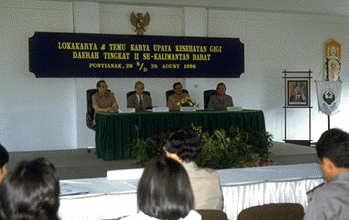
Conference in Singkawang

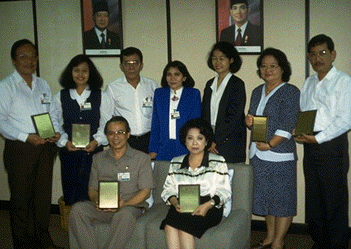
Dr Andreas and co-workers Dental Directorate, Ministry of Health, Jakarta
Pictures: Ketapang area

Travelling by boat from Pontianak to project site Ketapang


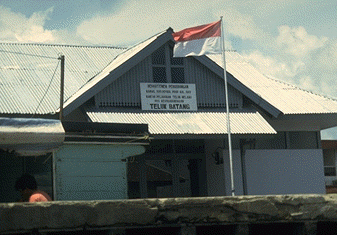
Passing trade post Teluk Batang


Delta of Kapuas river

Toothbrushing at school in Ketapang







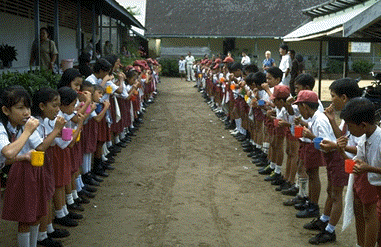




Pictures: Sanggau area


The road to Kedukul (one of the project sites), East of Sanggau, near Kapuas river - not always in good condition!


Children of Kedukul schools, participating in the project
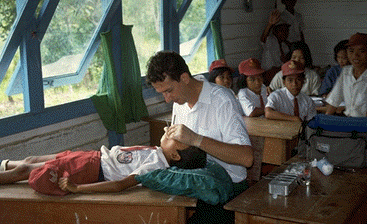


Dr Peter Carlsson, from Malmö University, Sweden external examiner, here examining children in Kedukul
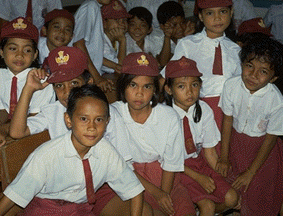

Children from the Kedukul schools
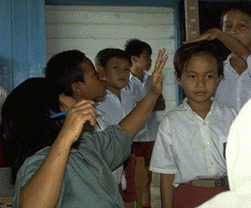
Measurements of length of children in Kedukul
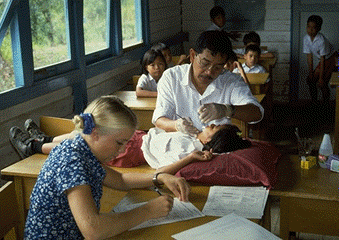
Examination and record


Small "shop" in Kedukul school
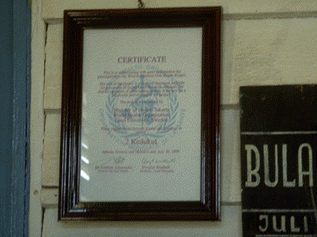
Certificate of participation in the West Kalimantan project framed and exposed in a Kedukul school
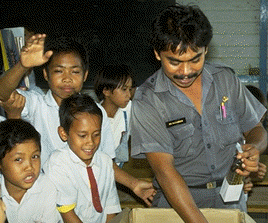
Dr Nazaruddin, dentist from Sanggau

Dr Utoyo from Ministry of Health, Jakarta, entertaining the children after examination


The children will miss Dr Utoyo!

Finishing examination in Kedukul. Members of research team and school teachers

Åsa Bratthall assisted as recorder of data

Prof. Bratthall somewhere in the middle....



Kapuas river East of Sanggau, near Semuntai

Pictures: The Independence Day, Celebrations in Singkawang




Independence Day in Indonesia, 1996 Celebrations in Singkawang, West Kalimantan (Borneo)




Independence Day in Indonesia, 1996 Celebrations in Singkawang, West Kalimantan (Borneo)



Independence Day in Indonesia, 1996 Celebrations in Singkawang, West Kalimantan (Borneo)



Independence Day in Indonesia, 1996 Celebrations in Singkawang, West Kalimantan (Borneo)



Independence Day in Indonesia, 1996 Celebrations in Singkawang, West Kalimantan (Borneo)
